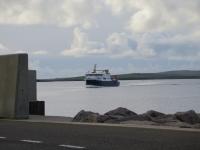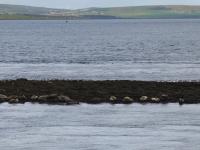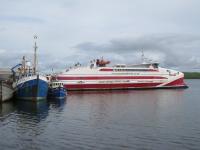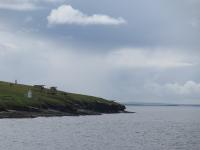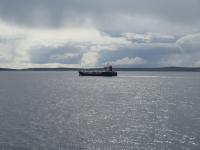Profile
Blog
Photos
Videos
Today I finally got to Orkney, and the sun shone all day - I had to break out the suncream!
Yesterday's excursions on Cape Wrath must've taken it out on me as I slept for a full 8 hours! Therefore it was, by my standards, a lazy start to the day. When checking out after another lovely breakfast (the sausage in particular was special) I asked about accessing the lovely beach I could see from my room, but it turns out that because it's the other side of the river it involves a drive followed by a 1 mile walk. This would've made getting to the ferry a bit tight, so instead he showed me where I could get another great view, and suggested I visit Farr Bay, just outside Bettyhill. So I followed his advice - and he was right!
I then made for Dunnet Head, via a brief petrol stop in Thurso. Dunnet Head is the northern most point of the British mainland and a place I visited last year. However, I decided to go again so that I could get a preview of Orkney as the island of Hoy is visible - and it was a lot less windy than last year!
Next I revisited The Castle of Mey, but only for the tearoom. Here I tucked into a lovely Cheese and Ham Toastie and Diet Coke. Then I drove to Gills Bay Ferry Terminal, where I arrived 20 minutes before check in closed.
The ferry is a catamaran, so not roll-on-roll-off. This means that cars were loaded in a horseshoe arrangement around the outside of the vehicle deck, and then the rest in the middle. As soon as we left the dock, a chorus of car alarms started as many drivers hadn't disabled their alarms. The Minx stayed quiet as I hadn't locked her doors.
The crossing was calm and offered some great views as we passed the islands of Stroma and South Ronaldsay. After an hour we arrived at St. Margaret's Hope, in the north of South Ronaldsay.
I immediately went to the south of the island, while virtually everyone else went in the opposite direction, to visit two neolithic tombs.
The first was The Tomb of The Otters, aka Banks' Tomb. This was only discovered 10 years ago when a bistro and accompanying car park was being built. No-one realised exactly what it was that was getting in the way, so they left it and built the car park around it. It was only three years later when someone stuck a camera into the mound and saw a skull that they found it was a 5,000 year old tomb. After the fascinating introduction, I was shown the tomb. To get through the tiny entrance I had to get on my hands and knees. The tomb is unique in that it hasn't been fully excavated yet but I'd open to the public - so the one excavated chamber can be seen and the others are still full of earth. The tomb got it's name because there is plenty of evidence that otters lived among the bodies - otter skeletons and droppings and possibly buried there too
The second site was just a mile away and known as The Tomb of The Eagles. This is another 5,000 year old tomb, but the site also includes a much more recent Bronze Age site - only 3,000 years old. After an interesting introductory talk, the tomb was reached by a circular walk that was just over a mile long. The entrance to the tomb is, again, tiny. However, a trolley is provided to aid ingress and egress. Once inside, I could stand up straight and see the fully excavated chambers which followed the same layout as the Tomb of the Otters. The concrete roof has sky lights to light up the interior - sadly the original roof was destroyed well before the tomb was discovered. It got its name from the number of White Tailed Eagle bones discovered. Some human bodies were buried with more eagle bones than others, so they were probably some sort of status symbol.
I then drove back up the island a short distance to Olav's Wood. This is a beautiful off-the-beaten-track haven for wildlife that follows the course of a burn. The start of the walk passes through the youngest part of the wood, full of saplings. There are several paths to follow, but they all lead to Helen's Wood - the oldest and densest part of the wood. It's named after Helen Manson who undertook the earliest planting. Consisting of mature spruce trees, it is like entering Into The Woods of fairytales - both eerie and beautiful.
It was now time to head to Mainland Orkney. Fortunately, although I had to cross several islands, another ferry trip was not necessary - thanks to the Churchill Barriers. Nestling in the middle of this group of islands is Scapa Flow - an important naval base. However, in the second World War, it was open to U-Boat attacks due to the number of entrances available between the islands - and the Royal Oak was torpedoed and sunk here. Therefore, to make it easier to defend, Churchill ordered the construction of barriers between the islands of the eastern approaches. These are now vital road links and enabled me to drive from South Ronaldsay via Burray, Glimps Holm and Lamb Holm to reach Mainland, crossing four barriers. Alongside a couple of the barriers blockships, previous attempts to block the entrances, can still be seen.
I made for one of the two main towns, Kirkwall, to find somewhere to eat, and stumbled across a chippy! So I had Haggis and Chips and Cheese, but no gravy! However, I have at last found a chippy that sells Battered Mars Bar, so had to try that. I parked next to the harbour to eat my delicious meal - and the Mars was lovely.
Then I checked in to my home for the next 9 nights. Fortunately, first impressions are that it's lovely!
Today we drove 106 miles.
- comments





